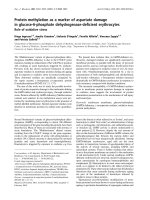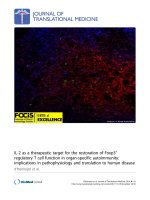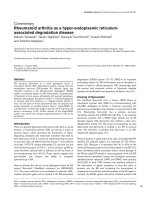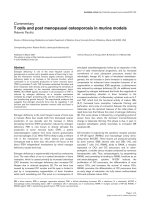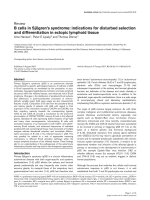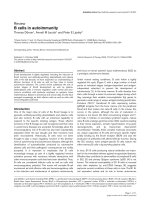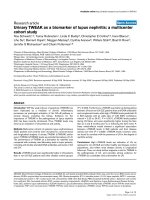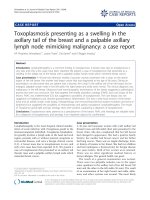Báo cáo y học: "B cells as a therapeutic target in autoimmune disease" doc
Bạn đang xem bản rút gọn của tài liệu. Xem và tải ngay bản đầy đủ của tài liệu tại đây (54.35 KB, 5 trang )
131
ACR 20 (50) (70) criteria = American College of Rheumatology criteria for 20% (50%) (70%) improvement; RA = rheumatoid arthritis; SLE = sys-
temic lupus erythematosus.
Available online />Introduction
The discovery of autoantibodies in chronic inflammatory
diseases initiated an era of clinical investigation and estab-
lished the foundation of modern clinical immunology. The
original descriptions of antinuclear antibodies by Holman
and Kunkel [1] and of rheumatoid factor by Rose and col-
leagues [2] were followed by the identification of numer-
ous self-antigens that were recognized by autoantibodies.
Antibodies to different autoantigens have remained one of
the most important diagnostic tests in clinical immunology.
In some diseases, these antibodies have been directly
implicated in tissue damage. It is, therefore, not surprising
that humoral autoimmunity was at center stage in the
1960s and 1970s and that various treatment approaches
were designed to interfere specifically with autoantibody
production or to remove autoantibodies from the circula-
tion. Plasmapheresis was explored in the treatment of a
variety of autoimmune syndromes, including systemic
lupus erythematosus (SLE), rheumatoid arthritis (RA), and
vasculitic syndromes. Plasmapheresis still has an
accepted role in thrombotic thrombocytopenic purpura
and cryoglobulinemia; however, in other chronic inflamma-
tory diseases, plasmapheresis has had disappointing
results. After 1980, treatment strategies no longer
focused on the B cell and the removal of autoantibodies
but, rather, focused on effector mechanisms of
macrophages and the cytokines that are produced in
inflammatory responses. Thus, the success of recent pilot
studies that explored B-cell depletion as a therapeutic
strategy came unexpectedly and has renewed interest in
reconsidering the role of the B cell in these diseases [3,4].
A new therapeutic strategy – targeting
CD20
+
B cells
All pilot studies of B-cell-depleting treatments have tar-
geted the CD20 antigen using a chimeric mouse/human
antibody, rituximab. Expression of CD20 is restricted to
B cells from the pre-B-cell stage to the immunoblast stage
[5]. Lymphoid precursors and plasma cells are spared in
CD20-directed depletion. CD20 is not shed from the cell
surface and does not internalize upon antibody binding
[6]. Rituximab binds complement and induces antibody-
dependent cellular cytotoxicity, effectively depleting
CD20-expressing cells. In addition, signaling via CD20
Commentary
B cells as a therapeutic target in autoimmune disease
Jörg J Goronzy and Cornelia M Weyand
Departments of Medicine and Immunology, Mayo Clinic, Rochester, MN, USA
Corresponding author: Jörg J Goronzy (e-mail: )
Received: 6 Jan 2003 Revisions requested: 5 Feb 2003 Revisions received: 17 Feb 2003 Accepted: 25 Feb 2003 Published: 19 Mar 2003
Arthritis Res Ther 2003, 5:131-135 (DOI 10.1186/ar751)
© 2003 BioMed Central Ltd (Print ISSN 1478-6354; Online ISSN 1478-6362)
Abstract
Depleting B cells with anti-CD20 monoclonal antibodies emerges as a new therapeutic strategy in
autoimmune diseases. Preliminary clinical studies suggest therapeutic benefits in patients with classic
autoantibody-mediated syndromes, such as autoimmune cytopenias. Treatment responses in
rheumatoid arthritis have opened the discussion about whether mechanisms beyond the removal of
potentially pathogenic antibodies are effective in B-cell depletion. B cells may modulate T-cell activity
through capturing and presenting antigens or may participate in the neogenesis of lymphoid
microstructures that amplify and deviate immune responses. Studies exploring which mechanisms are
functional in which subset of patients hold the promise of providing new and rational treatment
approaches for autoimmune syndromes.
Keywords: autoantibody, autoimmunity, B-cell depletion, rheumatoid arthritis, systemic lupus erythematosis
132
Arthritis Research & Therapy Vol 5 No 3 Goronzy and Weyand
appears to activate proapoptotic pathways, further
increasing the antibody’s depleting activity [7]. Rituximab
has been used in the treatment of B-cell non-Hodgkin’s
lymphoma as a single agent as well as in combination
therapy, emphasizing its high B-cell-depleting potency [8].
In patients with lymphoma, rituximab infusion is frequently
associated with a cytokine-release syndrome that probably
results from CD20-mediated stimulation of tumor cells [9].
B-cell levels slowly recover over a period of approximately
6 months. Despite B-cell depletion, immunoglobulin levels
are usually maintained, possibly as a consequence of
plasma cells being spared.
B-cell depletion in antibody-mediated diseases
It is understandable that rituximab has been most fre-
quently explored in autoimmune cytopenias, a disease
group that is clearly linked to the function of pathogenic
autoantibodies. The best response rates were found for
hemolytic anemia in cold agglutinin disease, approaching
85% in one prospective study [10,11]. In other autoim-
mune cytopenias, such as other forms of hemolytic anemia
or chronic autoimmune thrombocytopenia, response rates
are lower and range from 30 to 50% [12–14]. These data
confirm that, at least in some patients, plasma cells are not
sufficient to maintain autoantibody levels and that continu-
ous B-cell recruitment and activation are necessary to
maintain autoantibody production. Some of the treated
patients relapsed after the repopulation of B cells, consis-
tent with the model that the breakdown of self-tolerance
and the production of autoantibodies reflect a defect in
T-cell biology and not a primary B-cell dysfunction.
However, some patients have sustained remissions, sug-
gesting that the depletion of autoimmune memory B cells
can have a long-lasting effect. Loss of B-cell memory func-
tion has also been pinpointed as a cause of serious side
effects in anti-CD20-directed therapy. Patients with B-cell
lymphoma who received anti-CD20 antibody treatment
experienced reactivated hepatitis B and parvovirus infec-
tion [15–17]. This is of particular concern in patients with
hepatitis-C-associated mixed cryoglobulinemia. Prelimi-
nary data support the notion that the treatment is safe in
these patients; however, larger studies with careful moni-
toring of hepatic outcome are awaited. A trial to be spon-
sored by the US National Institutes of Health is in the
planning stage.
Although autoantibodies in autoimmune cytopenias and
some other diseases, such as pemphigus and myasthenia
gravis, have a direct role in tissue injury through the recog-
nition of their antigen, their pathogenic roles in diseases
such as Wegener’s granulomatosis and SLE are less well
defined. Experiences with B-cell depletion in these dis-
eases are based on a few uncontrolled case reports.
Specks and colleagues reported one patient with Wegen-
er’s granulomatosis who responded twice to B-cell deple-
tion [18]. Treatment responses correlated with the
diminution of antineutrophil cytoplasmic autoantibodies.
Most of the initial case reports in patients with SLE
involved patients with autoimmune hemolytic anemia. In a
recent report, Leandro and colleagues described six
patients with a variety of SLE manifestations who were
treated with rituximab [19]. These six patients included
three with WHO class IV nephritis at the time of treatment.
Five of the six responded to varying degrees, the median
BILAG (British Isles Lupus Assessment Group) global
scores dropped from 14 (range 9–27) to 6 (range 3–8) at
6 months. All the patients continued to have fluctuations in
disease activity and two had major relapses at 7 to
8 months, at a time when the B cells started to repopulate
the immune system. Of interest, titers of double-stranded
DNA antibody showed a variable response – all the
patients had elevated titers, and a convincing titer
decrease was seen in only two. Although encouraging, the
overall results do not allow for any conclusions as to
whether autoantibody production in patients with SLE is
dependent on continuous recruitment and activation of
B cells and whether transient B-cell depletion has an ame-
liorating effect on disease manifestations.
B-cell depletion in patients with rheumatoid
arthritis
Most data on the effects of B-cell depletion in autoimmu-
nity are available from patients with RA. Initially, Edwards
and Cambridge reported on five patients with refractory
RA, all of whom had major improvement in disease activity
and achieved responses meeting ACR 70 criteria (Ameri-
can College of Rheumatology criteria for 70% improve-
ment) [20]. These results were surprising because the
prevailing paradigm of RA pathogenesis emphasizes the
role of macrophage and fibroblast activation and the pro-
duction of inflammatory mediators in the synovial tissue.
Therapeutic effects of B-cell depletion obviously support
the concept that cellular immune mechanisms and auto-
antibody production are critically involved in the disease
process. The initial case reports were difficult to interpret,
because all patients undergoing B-cell depletion also
received high doses of steroids and intravenous
cyclophosphamide, which are able to suppress cells of
the innate immune system and to affect the production of
inflammatory cytokines on their own. It was, therefore, very
encouraging that DeVita and colleagues, who treated five
patients, could confirm the initial observation [21]. Clinical
responses were less impressive: only one patient
achieved an ACR 70 response and another one an ACR
50 response. However, all five patients had failed to
respond to previous treatments and did not receive con-
comitant immunosuppressive therapy. At the 2002 Ameri-
can College of Rheumatology meeting, Edwards reported
preliminary results on 122 patients of a prospective ran-
domized trial with 160 patients [22]. Thirty-two percent of
the rituximab-treated patients with RA met the ACR 50 cri-
teria, compared with 10% in the control group, further
133
supporting the notion that anti-CD20 treatment is benefi-
cial in at least a subset of patients with RA.
Mechanisms of anti-CD20 treatment in
rheumatoid arthritis
The question of which patients with RA respond to anti-
CD20 treatment and whether the response is transient or
long-term is directly linked to the role of B cells in the
pathogenesis of RA [23,24]. One obvious possibility is
that CD20 depletion suppresses the production of
rheumatoid factor or other autoantibodies that have been
described in RA. Indeed, decreased titers for rheumatoid
factor were found in some patients after rituximab treat-
ment, again supporting the notion that plasma cells are not
sufficient and that active B-cell responses are needed to
maintain these autoantibodies [25]. K/BXN mice, trans-
genic for a T-cell receptor specific for a widespread
autoantigen, develop aggressive joint inflammation in strict
dependence on autoantibodies [26]. Rheumatoid factors
have been shown to enhance the activation of comple-
ment, and immune complexes containing IgG rheumatoid
factor can crosslink Fcγ (crystallizable fragment gamma)
receptors. However, in contrast to the animal model,
neither for rheumatoid factor nor for any of the other
autoantibodies in RA has an effector function been
demonstrated that could be linked to joint inflammation.
Disease activity in RA is usually not correlated with
rheumatoid factor titers, and previous therapeutic attempts
to reduce rheumatoid factor load have not yielded con-
vincing clinical results [27]. One possible explanation is
that it is not the removal of autoantibody but the depletion
of B cells that is pivotal for treatment success in RA.
One important immunological function of B cells is their
ability to capture and take up antigen via their antigen-spe-
cific receptor and present the processed antigen in the
context of MHC class II antigens to stimulate CD4
+
T cells
[28]. The selective uptake by antigen-specific B cells is far
superior to the nonspecific uptake by other professional
antigen-presenting cells. Thus, the repertoire of B cells
determines which antigen is efficiently presented, particu-
larly at low antigen doses. The B-cell repertoire is grossly
abnormal in patients with RA: Chiorazzi and colleagues
have shown that it is markedly contracted [29]. Whether
this contraction is reversible with B-cell depletion remains
to be explored. The chances of restoring a highly diverse
B-cell repertoire are certainly higher for B cells than for
T cells, whose repertoire is also markedly contracted in
patients with RA [30]. However, attempts to restore diver-
sity by T-cell depletion have fundamentally failed, most
likely due to lack of thymic competence [31,32]. In con-
trast, the ability to generate new B cells appears less com-
promised with advancing age and disease. In addition,
rituximab spares precursor B cells and thus should not
compromise the host’s ability to regenerate a healthy and
diverse B-cell pool.
The antigen-presenting function of B cells is of particular
relevance for those that produce rheumatoid factor. Cell-
surface immunoglobulins with rheumatoid factor speci-
ficity enable the B cell to capture and ingest IgG immune
complexes, which can contain a variety of different
exogenous and endogenous antigens. Such antigens are
presented to T cells and initiate a T-cell response.
Carson and colleagues have hypothesized that this is the
main function of physiological rheumatoid-factor-produc-
ing B cells, which are preferentially found in the mantle
zones of lymphoid follicles [33]. Expansion of a B-cell
subset specialized in the uptake and presentation of
immunocomplexed antigens could shift the balance
between T-cell tolerance and T-cell immunity, providing a
unique pathomechanism for RA. Depletion of such
B cells with rituximab could possibly restore this
balance.
A second important regulatory role of B cells relates to
their contribution to lymphoid follicle and germinal center
formation [34]. B-cell differentiation and B-cell memory for-
mation are critically linked to cell–cell interactions that
occur in these specialized microstructures. Complex three-
dimensional arrangements of lymphocytes optimize the
capture and presentation of antigen and are excellent facili-
tators of T-cell stimulation [35]. The formation of ectopic
lymphoid microstructures is one of the characteristic find-
ings for the synovial lesions in RA [24]. Several molecular
pathways have been implicated in regulating the genera-
tion of functional germinal centers. The most important
were CXCL13, a chemokine determining the recruitment of
B cells, and lymphotoxin-β [34,36]. The requirement for
CXCL13 and lymphotoxin-β may be related to the forma-
tion of follicular dendritic cell networks, essential structural
elements of germinal centers. Ectopic lymphoid follicles are
formed in the synovial tissue in about 40% of all patients
with RA. In about one-half of these patients, follicles have
an established network of follicular dendritic cells and
show characteristic features of germinal center transforma-
tion [37,38]. These synovial tissues are characterized by
high production of CXCL13 and lymphotoxin-β [39,40].
Several cellular sources for CXCL13 have been identified,
including endothelial cells and synovial fibroblasts. Lym-
photoxin-β was typically found on mantle-zone B cells. In
such synovial tissues, the T-cell responses are B-cell-
dependent. Depletion of B cells with rituximab in severe
combined immunodeficiency mice that were engrafted with
human synovium from patients with RA significantly sup-
pressed the production of interferon-γ and several
macrophage-derived cytokines such as tumor necrosis
factor-α and interleukin-1β [41]. Synovial lesions from ritux-
imab-treated patients have not been recovered for studies.
However, the experiments in the human-synovium–severe-
combined-immunodeficiency-mouse model bear close
resemblance to the human disease, and similar molecular
pathways can be expected to be affected.
Available online />134
Conclusion
The treatment studies with rituximab have created a new
treatment strategy that apparently acts upstream of the
current treatment regimens employing cytokine blockage
and that may be well suitable for a subset of patients.
Identifying the mechanisms by which B cells control
disease activity will be necessary to determine who will
benefit most from this treatment approach. RA currently
offers the best model for study. In applying this strategy,
one needs to discern which patient cohort would be best
served. Are the responder patients those 20% who have
germinal centers in the inflamed tissue; are the best candi-
dates those who have a severely contracted B-cell reper-
toire; or do patients who have high titers of rheumatoid
factors benefit the most? A second important question is
how long-lasting the response is. Patients with lymphoma
who have undergone rituximab treatment start to repopu-
late the B-cell compartment about 6 months after the
treatment ends. The kinetics appears to be similar in
patients with autoimmune diseases. On the positive side,
immunocompetence seems to be regained with the gener-
ation of new B cells. However, it is possible that B-cell
recovery coincides with disease relapse. Because anti-
body responses to rituximab itself occur infrequently,
retreatment is an option in most patients. However,
repeated cycles of B-cell depletion may seriously compro-
mise protective humoral immunity [42]. Other treatment
strategies targeting B cells are currently in development.
An interesting avenue is the disruption of cytokine net-
works that regulate B-cell development and survival, such
as the blockade of the cytokine, B lymphocyte stimulator
[43]. Understanding precisely how rituximab suppresses
autoimmunity holds promise for deciphering the role of
autoantibodies in human diseases and will be helpful in
identifying new therapeutic targets.
Competing interests
None declared.
Acknowledgements
Supported in part by grants from the National Institutes of Health (AR
42457, AR 41974 and AI 44142) and by the Mayo Foundation. We
thank James W Fulbright for assistance in preparing this manuscript
and Linda H Arneson for secretarial support.
References
1. Holman HR, Kunkel HG: Affinity between lupus erythematosus
serum factor and cell nuclei and nucleoprotein. Science 1957,
126:162-163.
2. Rose HM, Ragan C, Pearce E, Lipman MO: Differential aggluti-
nation of normal and sensitized sheep erythrocytes by sera of
patients with rheumatoid arthritis. Proc Soc Exp Biol Med
1948, 68:1-6.
3. Patel DD: B cell-ablative therapy for the treatment of autoim-
mune diseases. Arthritis Rheum 2002, 46:1984-1985.
4. Looney RJ: Treating human autoimmune disease by depleting
B cells. Ann Rheum Dis 2002, 61:863-866.
5. Stashenko P, Nadler LM, Hardy R, Schlossman SF: Characteri-
zation of a human B lymphocyte-specific antigen. J Immunol
1980, 125:1678-1685.
6. McLaughlin P: Rituximab: perspective on single agent experi-
ence, and future directions in combination trials. Crit Rev
Oncol Hematol 2001, 40:3-16.
7. Demidem A, Alas S, Lam T, Hariharan K, Hanna N, Bonavida B:
Chimeric anti-CD20 antibody (IDEC-C2B8) is apoptotic and
sensitizes drug-resistant human B cell lymphomas to the
cytotoxic effect of CDDP, VP1- and toxins [abstract]. FASEB J
1995, 9:A206.
8. Kosmas C, Stamatopoulos K, Stavroyianni N, Tsavaris N,
Papadaki T: Anti-CD20-based therapy of B cell lymphoma:
state of the art. Leukemia 2002, 16:2004-2015.
9. Maloney DG, Grillo-Lopez AJ, White CA, Bodkin D, Schilder RJ,
Neidhart JA, Janakiraman N, Foon KA, Liles TM, Dallaire BK, Wey
K, Royston I, Davis T, Levy R: IDEC-C2B8 (Rituximab) anti-CD20
monoclonal antibody therapy in patients with relapsed low-
grade non-Hodgkin’s lymphoma. Blood 1997, 90:2188-2195.
10. Lee EJ, Kueck B: Rituxan in the treatment of cold agglutinin
disease. Blood 1998, 92:3490-3491.
11. Berentsen S, Tjonnfjord GE, Brudevold R, Gjertsen BT, Langholm
R, Lokkevik E, Sorbo JH, Ulvestad E: Favourable response to
therapy with the anti-CD20 monoclonal antibody rituximab in
primary chronic cold agglutinin disease. Br J Haematol 2001,
115:79-83.
12. Giagounidis AA, Anhuf J, Schneider P, Germing U, Sohngen D,
Quabeck K, Aul C: Treatment of relapsed idiopathic thrombo-
cytopenic purpura with the anti-CD20 monoclonal antibody
rituximab: a pilot study. Eur J Haematol 2002, 69:95-100.
13. Patel K, Berman J, Ferber A, Caro J: Refractory autoimmune
thrombocytopenic purpura treatment with Rituximab. Am J
Hematol 2001, 67:59-60.
14. Stasi R, Pagano A, Stipa E, Amadori S: Rituximab chimeric anti-
CD20 monoclonal antibody treatment for adults with chronic
idiopathic thrombocytopenic purpura. Blood 2001, 98:952-
957.
15. Ng HJ, Lim LC: Fulminant hepatitis B virus reactivation with
concomitant listeriosis after fludarabine and rituximab
therapy: case report. Ann Hematol 2001, 80:549-552.
16. Song KW, Mollee P, Patterson B, Brien W, Crump M: Pure red
cell aplasia due to parvovirus following treatment with CHOP
and rituximab for B-cell lymphoma. Br J Haematol 2002, 119:
125-127.
17. Sharma VR, Fleming DR, Slone SP: Pure red cell aplasia due to
parvovirus B19 in a patient treated with rituximab. Blood
2000, 96:1184-1186.
18. Specks U, Fervenza FC, McDonald TJ, Hogan MC: Response of
Wegener’s granulomatosis to anti-CD20 chimeric monoclonal
antibody therapy. Arthritis Rheum 2001, 44:2836-2840.
19. Leandro MJ, Edwards JC, Cambridge G, Ehrenstein MR, Isenberg
DA: An open study of B lymphocyte depletion in systemic
lupus erythematosus. Arthritis Rheum 2002, 46:2673-2677.
20. Edwards JC, Cambridge G: Sustained improvement in rheuma-
toid arthritis following a protocol designed to deplete B lym-
phocytes. Rheumatology (Oxford) 2001, 40:205-211.
21. De Vita S, Zaja F, Sacco S, De Candia A, Fanin R, Ferraccioli G:
Efficacy of selective B cell blockade in the treatment of
rheumatoid arthritis: evidence for a pathogenetic role of B
cells. Arthritis Rheum 2002, 46:2029-2033.
22. Edwards JCW, Szczepanski L, Szechinski J, Filipowicz-Sos-
nowska A, Close D, Stevens RM, Shaw TM: Efficacy and safety
of Rituximab, a B-cell targeted chimeric monoclonal antibody:
A randomized placebo-controlled trial in patients with
rheumatoid arthritis [abstract]. Arthritis Rheum 2002, 46:S197.
23. Zhang Z, Bridges SLJ: Pathogenesis of rheumatoid arthritis.
Role of B lymphocytes. Rheum Dis Clin North Am 2001, 27:
335-353.
24. Weyand CM, Goronzy JJ, Takemura S, Kurtin PJ: Cell-cell inter-
actions in synovitis. Interactions between T cells and B cells in
rheumatoid arthritis. Arthritis Res 2000, 2:457-463.
25. Bernasconi NL, Traggiai E, Lanzavecchia A: Maintenance of
serological memory by polyclonal activation of human
memory B cells. Science 2002, 298:2199-2202.
26. Matsumoto I, Maccioni M, Lee DM, Maurice M, Simmons B,
Brenner M, Mathis D, Benoist C: How antibodies to a ubiqui-
tous cytoplasmic enzyme may provoke joint-specific autoim-
mune disease. Nat Immunol 2002, 3:360-365.
27. Felson DT, LaValley MP, Baldassare AR, Block JA, Caldwell JR,
Cannon GW, Deal C, Evans S, Fleischmann R, Gendreau RM,
Arthritis Research & Therapy Vol 5 No 3 Goronzy and Weyand
135
Harris ER, Matteson EL, Roth SH, Schumacher HR, Weisman
MH, Furst DE: The Prosorba column for treatment of refractory
rheumatoid arthritis: a randomized, double-blind, sham-con-
trolled trial. Arthritis Rheum 1999, 42:2153-2159.
28. Lanzavecchia A: Receptor-mediated antigen uptake and its
effect on antigen presentation to class II-restricted T lympho-
cytes. Annu Rev Immunol 1990, 8:773-793.
29. Itoh K, Patki V, Furie RA, Chartash EK, Jain RI, Lane L, Asnis SE,
Chiorazzi N: Clonal expression is a characteristic feature of
the B-cell repertoire of patients with rheumatoid arthritis.
Arthritis Res 2000, 2:50-58.
30. Wagner UG, Koetz K, Weyand CM, Goronzy JJ: Perturbation of
the T cell repertoire in rheumatoid arthritis. Proc Natl Acad Sci
USA 1998, 95:14447-14452.
31. Jendro MC, Ganten T, Matteson EL, Weyand CM, Goronzy JJ:
Emergence of oligoclonal T cell populations following thera-
peutic T cell depletion in rheumatoid arthritis. Arthritis Rheum
1995, 38:1242-1251.
32. Koetz K, Bryl E, Spickschen K, O’Fallon WM, Goronzy JJ, Weyand
CM: T cell homeostasis in patients with rheumatoid arthritis.
Proc Natl Acad Sci USA 2000, 97:9203-9208.
33. Carson DA, Chen PP, Kipps TJ: New roles for rheumatoid
factor. J Clin Invest 1991, 87:379-383.
34. Fu YX, Chaplin DD: Development and maturation of secondary
lymphoid tissues. Annu Rev Immunol 1999, 17:399-433.
35. Gretz JE, Anderson AO, Shaw S: Cords, channels, corridors
and conduits: critical architectural elements facilitating cell
interactions in the lymph node cortex. Immunol Rev 1997, 156:
11-24.
36. Cyster JG, Ngo VN, Ekland EH, Gunn MD, Sedgwick JD, Ansel
KM: Chemokines and B-cell homing to follicles. Curr Top
Microbiol Immunol 1999, 246:87-92.
37. Schroder AE, Greiner A, Seyfert C, Berek C: Differentiation of B
cells in the nonlymphoid tissue of the synovial membrane of
patients with rheumatoid arthritis. Proc Natl Acad Sci USA
1996, 93:221-225.
38. Wagner UG, Kurtin PJ, Wahner A, Brackertz M, Berry DJ, Goronzy
JJ, Weyand CM: The role of CD8+ CD40L+ T cells in the for-
mation of germinal centers in rheumatoid synovitis. J Immunol
1998, 161:6390-6397.
39. Takemura S, Klimiuk PA, Braun A, Goronzy JJ, Weyand CM: T cell
activation in rheumatoid synovium is B cell dependent. J
Immunol 2001, 167:4710-4718.
40. Shi K, Hayashida K, Kaneko M, Hashimoto J, Tomita T, Lipsky PE,
Yoshikawa H, Ochi T: Lymphoid chemokine B cell-attracting
chemokine-1 (CXCL13) is expressed in germinal center of
ectopic lymphoid follicles within the synovium of chronic
arthritis patients. J Immunol 2001, 166:650-655.
41. Takemura S, Braun A, Crowson C, Kurtin PJ, Cofield RH, O’Fallon
WM, Goronzy JJ, Weyand CM: Lymphoid neogenesis in
rheumatoid synovitis. J Immunol 2001, 167:1072-1080.
42. van der Kolk LE, Baars JW, Prins MH, van Oers MH: Rituximab
treatment results in impaired secondary humoral immune
responsiveness. Blood 2002, 100:2257-2259.
43. Zhang J, Roschke V, Baker KP, Wang Z, Alarcon GS, Fessler BJ,
Bastian H, Kimberley RP, Zhou T: Cutting edge: a role for B lym-
phocyte stimulator in systemic lupus erythematosus. J
Immunol 2001, 166:6-10.
Correspondence
Jörg J Goronzy, MD, Mayo Clinic, 200 First Street SW, Rochester, MN
55905, USA. Tel: +1 507 284 1650; fax: +1 507 284 5045; e-mail:
Available online />
